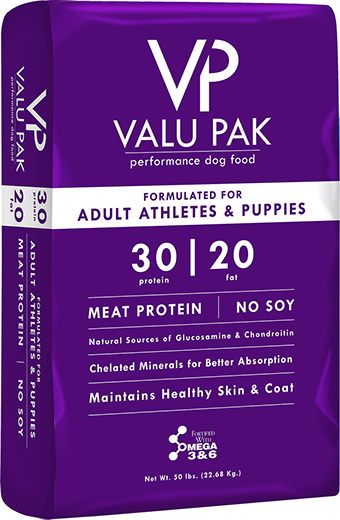
DogFoodAdvisor is reader supported See how
All reviews are 100% impartial but if you buy using links on this page, we may earn a referral fee.
Our Verdict
Valu-Pak dry dog food is made up of 10 recipes with ratings varying from 2 to 4.5 stars. The average rating of the whole range is 3 stars.
The label on each recipe clearly displays the protein and fat content on the front. Most foods also have clear labeling for allergen details and even the number of meats included in the food, thus making it easier to find the appropriate recipe for your dog.
Pros
- Recipes can be free of corn, wheat, soy, or gluten
- Higher protein levels in some recipes
- Reasonably priced
Cons
- Uses by-by-products instead of whole meats
The table below shows each recipe in this range including our rating and the AAFCO nutrient profile: Growth (puppy), Maintenance (adult), All Life Stages, Supplemental or Unspecified.
| Product line | Rating | AAFCO |
|---|---|---|
| Valu-Pak Free 28-20 | 4 | A |
| Valu-Pak Free 26-18 | 4 | A |
| Valu-Pak Free 24-20 | 3 | A |
| Valu-Pak Free 22-12 | 3 | A |
| Valu-Pak 30-20 | 4.5 | A |
| Valu-Pak 26-18 | 4 | A |
| Valu-Pak 24-20 | 2.5 | A |
| Valu-Pak 21-12 | 2 | A |
| Valu-Pak 21-8 | 2.5 | A |
| Valu-Pak 18-8 | 2.5 | A |
Recipe and Label Analysis
Valu-Pak 30-20 was selected to represent the other products in the line for a detailed recipe and nutrient analysis.
Valu-Pak 30-20
Estimated Dry Matter Nutrient Content
Protein
Fat
CarbsCarbohydrates
Chicken by-product meal (source of glucosamine & chondroitin), ground whole grain corn, chicken fat (preserved with mixed tocopherols), whole soft grain wheat, pork meal (source of glucosamine & chondroitin), rice bran, corn gluten meal, dried beet pulp (sugar removed), flaxseed meal, natural chicken flavor, salt, potassium chloride, calcium carbonate, hydrated sodium calcium aluminosilicate, choline chloride, zinc proteinate, d-alpha tocopheryl acetate (source of vitamin E), iron proteinate, ferrous sulfate, zinc sulfate, zinc oxide, l-ascorbate 2-phosphate (source of vitamin C), copper sulfate, sodium selenite, manganese proteinate, manganese sulfate, copper proteinate, niacin supplement (vitamin B3), biotin (vitamin B7), calcium pantothenate (vitamin B5), vitamin A supplement, riboflavin supplement (vitamin B2), thiamine mononitrate (vitamin B1), vitamin B12 supplement, calcium iodate (source of iodine), pyridoxine hydrochloride (vitamin B6), vitamin D3 supplement, cobalt carbonate, folic acid
Fiber (estimated dry matter content) = 3.5%
Red denotes any controversial items
| Estimated Nutrient Content | |||
|---|---|---|---|
| Method | Protein | Fat | Carbs |
| Guaranteed Analysis | 30% | 20% | NA |
| Dry Matter Basis | 33% | 22% | 37% |
| Calorie Weighted Basis | 27% | 44% | 30% |
Ingredients Analysis
The first ingredient is chicken by-products, what’s left of a slaughtered chicken after all the choice cuts have been removed.
In addition to organs, this item can also include feet, beaks, undeveloped eggs and almost anything other than prime skeletal muscle.
The quality of this ingredient can vary, depending on the caliber of the raw materials obtained by the manufacturer.
The second ingredient is ground whole grain corn. Whole grain corn contains all the essential parts and naturally-occurring nutrients of the entire grain seed in their original proportions. If the grain has been processed (e.g., cracked, crushed, rolled, extruded, and/or cooked), the food product should deliver the same rich balance of nutrients that are found in the original grain seed.
Whole grain corn contains fibers, protein, carbohydrates, vitamins and minerals. Aside from its energy content, however, this whole grain cereal is of only modest nutritional value to a dog.
The third ingredient is chicken fat. Chicken fat is obtained from rendering chicken, a process similar to making soup in which the fat itself is skimmed from the surface of the liquid.
Chicken fat is high in linoleic acid, an omega-6 fatty acid essential for life. Although it doesn’t sound very appetizing, chicken fat is actually a quality ingredient.
The fourth ingredient is whole soft grain wheat. Whole grain wheat contains all the essential parts and naturally-occurring nutrients of the entire grain seed in their original proportions. If the grain has been processed (e.g., cracked, crushed, rolled, extruded, and/or cooked), the food product should deliver the same rich balance of nutrients that are found in the original grain seed.
Whole grain wheat contains fibers, carbohydrates, vitamins and minerals. Aside from its energy content, however, this whole grain cereal is of only modest nutritional value to a dog.
The fifth ingredient is pork meal. Pork meal is considered a meat concentrate and contains nearly 300% more protein than fresh pork. Yet it can also be high in ash — about 25-30%.
However, the ash content of the final product is typically adjusted in the recipe to allow its mineral profile to meet AAFCO guidelines.
The sixth ingredient is rice bran, a healthy by-product of milling whole-grain rice. The bran is the fiber-rich outer layer of the grain containing starch, protein, fat as well as vitamins and minerals.
The seventh ingredient is corn gluten meal. Gluten is the rubbery residue remaining once corn has had most of its starchy carbohydrate washed out of it.
Although corn gluten meal contains 60% protein, this ingredient would be expected to have a lower biological value than meat.
And less costly plant-based products like this can notably boost the total protein reported on the label — a factor that must be considered when judging the actual meat content of this dog food.
The eighth ingredient is beet pulp. Beet pulp is a controversial ingredient, a high fiber by-product of sugar beet processing.
Some denounce beet pulp as an inexpensive filler while others cite its outstanding intestinal health and blood sugar benefits.
We only call your attention here to the controversy and believe the inclusion of beet pulp in reasonable amounts in most dog foods is entirely acceptable.
The ninth ingredient is flaxseed meal, one of the best plant-based sources of healthy omega-3 fatty acids. Flax meal is particularly rich in soluble fiber.
However, flaxseed contains about 19% protein, a factor that must be considered when judging the actual meat content of this dog food.
From here the list goes on to include a number of other items. But to be realistic, ingredients located this far down the list (other than nutritional supplements) are not likely to affect the overall rating of the product.
This recipe has two notable exceptions.
First chelated minerals, minerals that have been chemically attached to protein. This makes them easier to absorb. Chelated minerals are usually found in better dog foods.
Also sodium selenite, a controversial form of the mineral selenium. Sodium selenite appears to be nutritionally inferior to the more natural source of selenium found in selenium yeast.
Nutrient Analysis
Based on its ingredients alone, Valu-Pak 30-20 looks like an average dry product.
The dashboard displays a dry matter protein reading of 33%, a fat level of 22% and an estimated carbohydrate level of 36%.
As a group, the brand features a protein content of 27% and a mean fat level of 17%. Together these figures suggest a carbohydrate content of 48% for the overall product line, alongside a fat-to-protein ratio of 62%.
This means this product line contains near-average protein, near-average carbohydrate, and near-average fat when compared to typical dry dog food.
Valu-Pak Dog Food Recall History
The following automated list (if present) includes all dog food recalls related to Valu-Pak through December 2025.
No recalls noted.
You can view a complete list of all dog food recalls since 2009 here.
Our Rating of Valu-Pak Dog Food
The products in this range contain decent-quality ingredients. However, some ingredients could be of better quality. For example, using whole meats instead of by-products and whole rice instead of rice bran would be an improvement. Additionally, in three of the recipes, ground corn is used as the primary ingredient, which only provides moderate nutritional value to a dog… hence our overall rating of 3 stars.
About
Specialty Feeds was founded in 1960 by Vick, Gene & Bubba Coscia. From humble beginnings on their Gayoso Farms dairy in North Mississippi to their now seven-storey plant in Memphis, Tennessee.
Compare Valu-Pak Dog Food
How does Valu-Pak compare with The Dog Food Advisor's most recommended brands?
A Final Word
The Dog Food Advisor does not accept money, gifts, samples or other incentives in exchange for special consideration in preparing our reviews.
However, we do receive a referral fee from online retailers (like Chewy or Amazon) and from sellers of perishable pet food when readers click over to their websites from ours. This helps cover the cost of operation of our free blog. Thanks for your support.
For more information, please visit our Disclaimer and Disclosure page.






